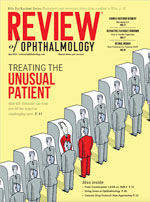Adding omega-3 fatty acids did not improve a combination of nutritional supplements commonly recommend-ed for treating age-related macu-lar degeneration, according to the AREDS2 study from the National Institutes of Health. The plant-derived antioxidants lutein and zeaxanthin also had no overall effect on AMD when added to the combination; however, they were safer than the related antioxidant beta-carotene, according to the study, published online in May in the Journal of the American Medical Association.
Millions of older Americans take nutritional supplements to protect their sight without clear guidance regarding benefit and risk,” said NEI director Paul A. Sieving, MD, PhD. “This study clarifies the role of supplements in helping prevent advanced AMD, an incurable, common and devastating disease that robs older people of their sight and independence.”
The Age-Related Eye Disease Study, which was led by NIH’s National Eye Institute and concluded in 2001, established that daily high doses of vitamins C and E, beta-carotene, and the minerals zinc and copper—called the AREDS formulation—can help slow the progression to advanced AMD. The American Academy of Ophthalmology now recommends use of the AREDS formulation to reduce the risk of advanced AMD. However, beta-carotene use has been linked to a heightened risk of lung cancer in smokers. And there have been concerns that the high zinc dose in AREDS could cause minor side effects, such as stomach upset, in some people.
In 2006 the NEI launched AREDS2, a five-year study designed to test whether the original AREDS formulation could be improved by adding omega-3 fatty acids; adding lutein and zeaxanthin; removing beta-carotene; or reducing zinc. The study also examined how different combinations of the supplements performed. Omega-3 fatty acids are produced by plants, including algae, and are present in oily fish such as salmon. Lutein and zeaxanthin are carotenoids, a class of plant-derived vitamins that includes beta-carotene; both are present in leafy green vegetables and, when consumed, they accumulate in the retina. Prior studies had suggested that diets high in lutein, zeaxanthin and omega-3 fatty acids protect vision. Before the AREDS2 study finished, manufacturers began marketing supplements based on the study design.
In AREDS2, participants took one of four AREDS formulations daily for five years. The original AREDS included 500 milligrams vitamin C, 400 international units of vitamin E, 15 mg beta-carotene, 80 mg zinc and 2 mg copper. Other groups took AREDS with no beta-carotene, AREDS with low zinc (25 mg), or AREDS with no beta-carotene and low zinc. Participants in each AREDS group also took one of four additional supplements or combinations: these included lutein/zeaxanthin (10 mg/2 mg), omega-3 fatty acids (1,000 mg), lutein/zeaxanthin and omega-3 fatty acids, or placebo. Progression to advanced AMD was established by examination of retina photographs or treatment for advanced AMD.
In the first AREDS trial, participants with AMD who took the AREDS formulation were 25 percent less likely to progress to advanced AMD over the five-year study period, compared with participants who took a placebo. In AREDS2, there was no overall additional benefit from adding omega-3 fatty acids or a 5-to-1 mixture of lutein and zeaxanthin to the formulation. However, the investigators did find some benefits when they analyzed two subgroups of participants: those not given beta-carotene, and those who had very little lutein and zeaxanthin in their diets.
“When we looked at just those participants in the study who took an AREDS formulation with lutein and zeaxanthin but no beta-carotene, their risk of developing advanced AMD over the five years of the study was reduced by about 18 percent, compared with participants who took an AREDS formulation with beta-carotene but no lutein or zeaxanthin,” said Emily Chew, MD, deputy director of the NEI Division of Epidemiology and Clinical Applications and the NEI deputy clinical director. “Further analysis showed that participants with low dietary intake of lutein and zeaxanthin at the start of the study, but who took an AREDS formulation with lutein and zeaxanthin during the study, were about 25 percent less likely to develop advanced AMD compared with participants with similar dietary intake who did not take lutein and zeaxanthin.”
Because carotenoids can compete with each other for absorption in the body, beta-carotene may have masked the effect of the lutein and zeaxanthin in the overall analysis, Dr. Chew said. Indeed, participants who took all three nutrients had lower levels of lutein and zeaxanthin in their blood compared to participants who took lutein and zeaxanthin without beta-carotene.
Removing beta-carotene from the AREDS formulation did not curb the formulation’s protective effect against developing advanced AMD, an important finding because several studies have linked taking high doses of beta-carotene with a higher risk of lung cancer in smokers. Although smokers were not given a formulation with beta-carotene in AREDS2, the study showed an association between beta-carotene and risk of lung cancer among former smokers. About half of AREDS2 participants were former smokers. “Removing beta-carotene simplifies things,” said Wai T. Wong, MD, PhD, chief of the NEI Neuron-Glia Interactions in Retinal Disease Unit and a co-author of the report. “We have identified a formulation that should be good for everyone regardless of smoking status,” he said. Adding omega-3 fatty acids or lowering zinc to the AREDS formulation also had no effect on AMD progression.
More than 4,000 people, ages 50 to 85 years, who were at risk for advanced AMD participated in AREDS2 at 82 clinical sites across the country.
In a separate study, published online in JAMA Ophthalmology, the AREDS2 Research Group evaluated the effect of the various AREDS formulas on cataract. As reported in 2001, the original AREDS formulation does not protect against cataract. In AREDS2, none of the modified formulations helped reduce the risk of progression to cataract surgery, although a subgroup of participants with low dietary lutein and zeaxanthin gained some protection. “While a healthy diet promotes good eye health and general well-being, based on overall AREDS2 data, regular high doses of antioxidant supplements do not prevent cataract,” Dr. Chew said.
Scientists are unsure how supplements in the AREDS formulation exert their protective effects. However, an April 2013 report in Ophthalmology by the AREDS Research Group shows the beneficial effects of taking the AREDS vitamins are long-lasting. In a follow-up study of AREDS participants, those who took the AREDS formulation during the initial five-year trial were 25 to 30 percent less likely to develop advanced AMD—mostly due to a reduction in the number of neovascular AMD cases—over the next five years, compared with participants who took placebo during AREDS. Seventy percent of all participants were taking the original AREDS formula by the end of the follow-up period.
“Long-term use of AREDS supplements appears safe and protective against advanced AMD,” said Dr. Chew. “While zinc is an important component of the AREDS formulation, based on evidence from AREDS2 it is unclear how much zinc is necessary. Omega-3 fatty acids and beta-carotene clearly do not reduce the risk of progression to advanced AMD; however, adding lutein and zeaxanthin in place of beta-carotene may further improve the formulation.”
VEGF Implicated In Trab Scarring
The most common cause of failure after glaucoma surgery is scarring at the surgical site, so researchers are actively looking for ways to minimize or prevent scar formation. Previous work had suggested that vascular endothelial growth factor activates fibrosis, whereas VEGF inhibition results in reduced scar formation and better surgical results. In a series of studies using a rabbit model of glaucoma surgery, investigators have determined that VEGF probably exerts its effects through induction of transforming growth factor (TGF)-β1, which may open up a new target for therapies to improve glaucoma surgical outcomes. This study is published in the June 2013 issue of the American Journal of Pathology.
“The cytokine TGF-β1 is a key mediator of wound healing and is critically involved in postoperative scarring,” says Chan Kee Park, MD, PhD, Department of Ophthalmology and Visual Science of Seoul St. Mary’s Hospital and the College of Medicine of the Catholic University of Korea. “Our present study shows that VEGF induces TGF-β1 production, and inhibiting VEGF reduces TFG-β1 levels … and decreases subconjunctival fibrosis after trabeculectomy.”
In this study of 32 white rabbits, some underwent trabeculectomy and others remained unoperated as controls. Immediately after surgery, some rabbits received intraocular injections of 0.2 ml of VEGF at doses ranging from 1 to 50 µg/mL, while others were injected with the VEGF inhibitor bevacizumab in the subconjunctival space.
One of the questions addressed by the researchers was whether VEGF triggers the transformation of fibroblasts to myofibroblasts in the subconjunctiva, since myofibroblasts play a significant role in fibrosis. Using immunohistochemical staining, the researchers found that trabeculectomy activated myoblast transformation as measured by levels of Smad-positive and Snail-positive cells in the conjunctiva and subconjunctiva. This effect increased after VEGF stimulation. Similarly, Western blot analysis of proteins showed increased levels of Smad, phosphorylated Smad and Snail after surgery, which was intensified by VEGF and inhibited by bevacizumab.
“Our findings suggest that VEGF has potential effects on the TGF-β1/Smad/Snail pathway involved in myoblast transformation. Our study gives an experimental basis for the use of anti-VEGF agents in glaucoma surgery,” says Dr. Park.
Freeing Cholesterol To Combat AMD
A central feature of age-related macular degeneration is an accumulation of cholesterol in the macrophages, which has been shown to cause the abnormal blood vessel growth characteristic of AMD.
To discover why cholesterol builds up in the macrophages of AMD patients, researchers looked at macrophages from older mice and humans with AMD. Both the older mice and human AMD patients had low levels of the cholesterol transporter ABCA1. Without appropriate amounts of ABCA1, macrophages were unable to move cholesterol out of the eyes and could not prevent abnormal blood vessels from forming.
Experimenting with two cholesterol regulators called Liver X Receptor and microRNAs-33, researchers found that both medications helped to move cholesterol out of the macrophages and reduce abnormal blood vessel growth in the eyes of older mice.
Furthermore, the drugs can be administered via eye drops or injection. It is even hoped that delivering medications through eye drops will reduce the number of possible side effects. REVIEW



